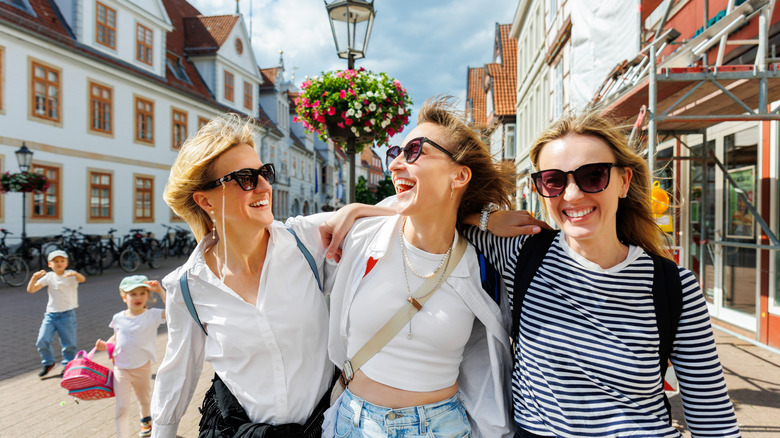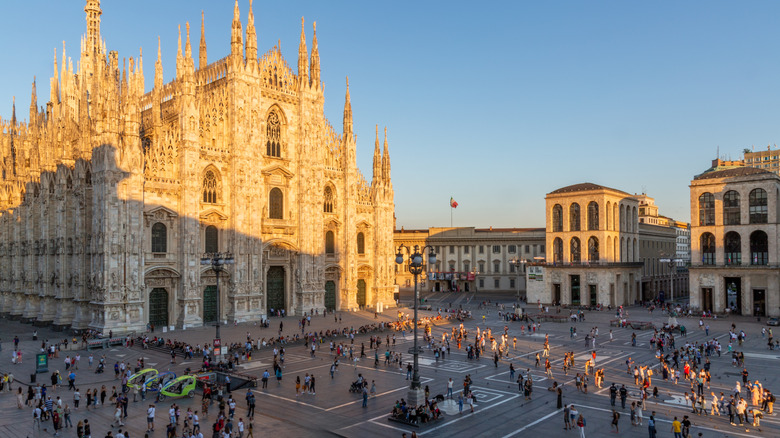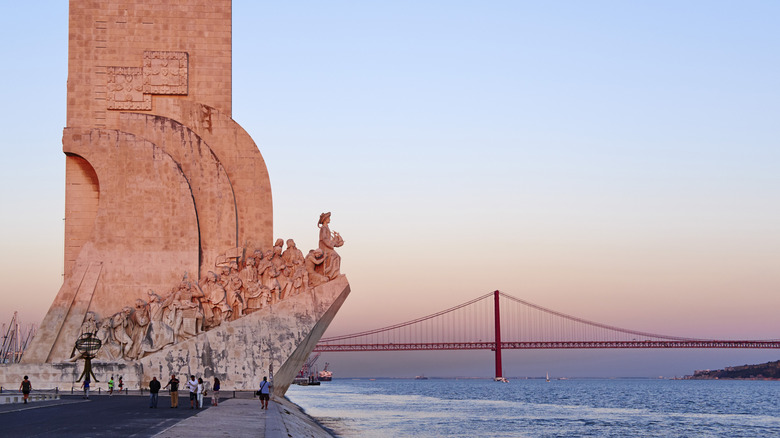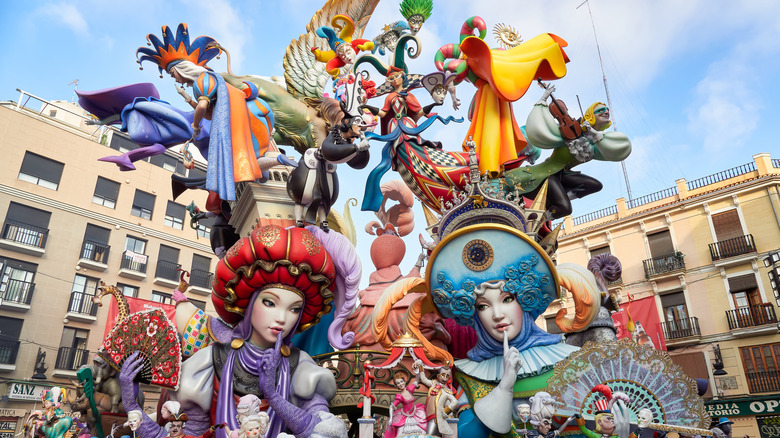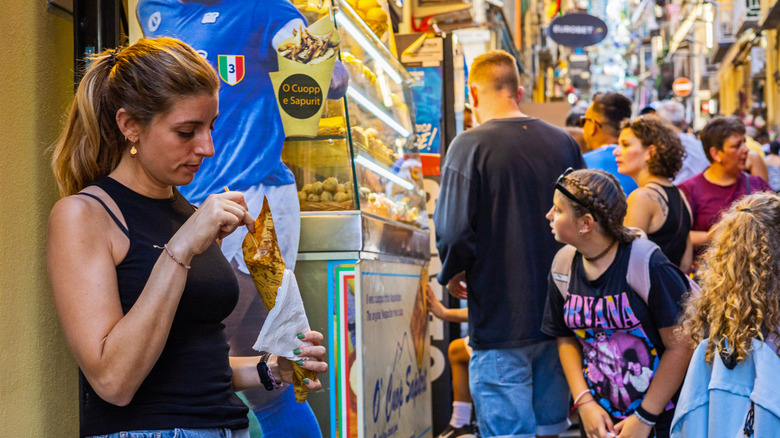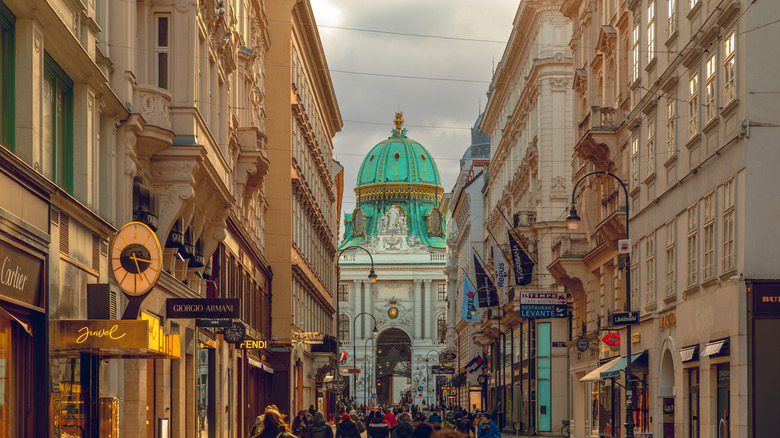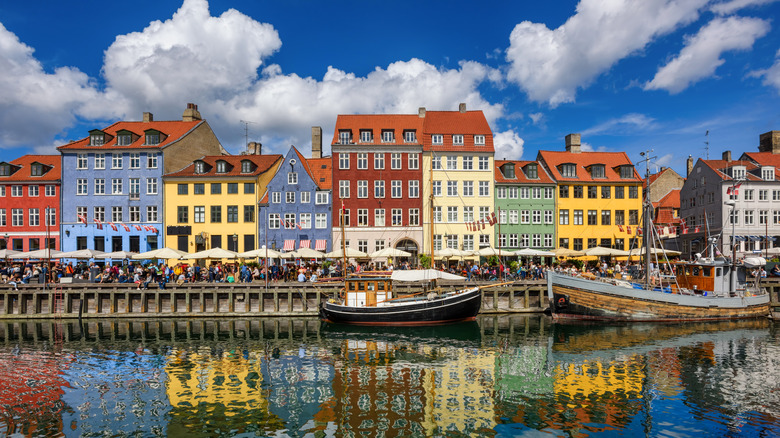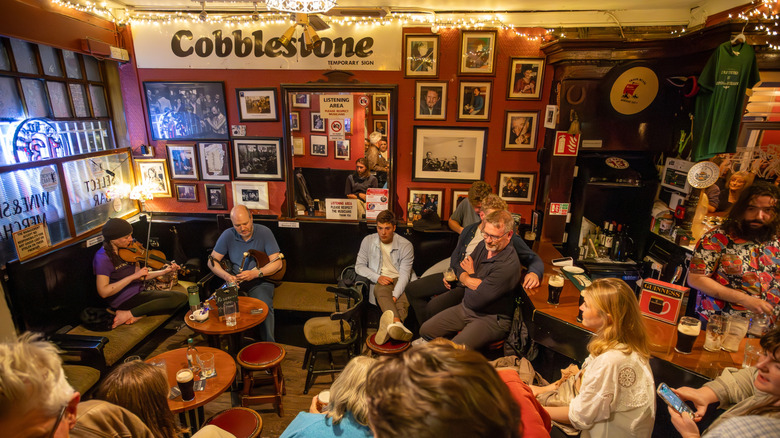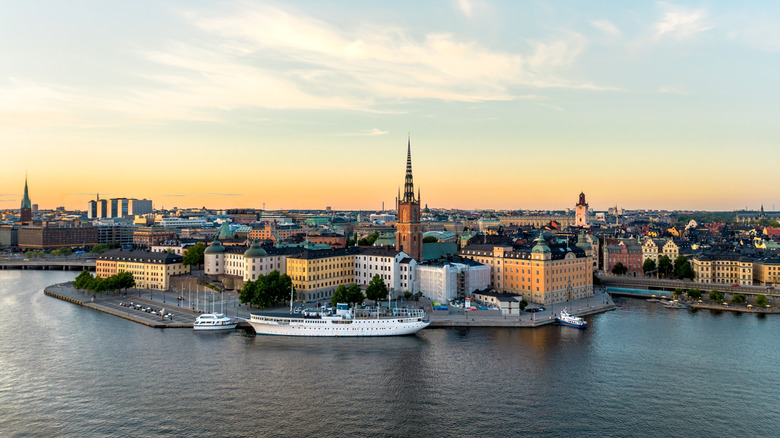The Friendliest Cities To Visit In Europe
Europe is divided into 44 or 50 countries, with the discrepancy largely dependent on who is counting. Such diversity brings with it a slew of cultural norms and values that are, at times, at odds with one another. Italians greet each other with hugs and kisses; Danes stick to firm handshakes. Swedes treat small talk like a contagious disease, Brits use insults as a sign of affection, and Russians rarely smile in public. It can be a little confusing at times.
The truth is that Europe is a genuinely welcoming place, and identifying national idiosyncrasies does nothing to detract from that simple reality. Still, finding and sorting out the generically approachable places in Europe from the true paragons of affability requires a little research. In some cases, it's not even a question of national character. The people of Manchester in the U.K. are some of the warmest, most welcoming people on the planet, but the same cannot always be said for Londoners. Or perhaps it's the other way around? Such observations are subjective by their very nature.
Still, a consensus opinion is far from a pipe dream. Surveys have been carried out, anecdotes assimilated, and personal experience remains the gold standard of travel advice. Here, then, are the friendliest cities to visit in Europe, according to someone who has traveled to more than his fair share of them.
Palma de Mallorca, Balearic Islands, Spain
When one turns their mind to Europe, the island of Mallorca does not naturally spring to mind, which is a shame, really. To start with, it just so happens to be one of those must-visit islands blessed with historic landmarks and beautiful beaches. Second, while its capital, Palma, doesn't roll off the tongue in quite the same way as London, Paris, or Milan, its lively nightlife, café culture, and boutique shopping experiences rival those of cities many times its size. Oh, and it's also filled with super-friendly people. Indeed, part of the reason for its reputation as a welcoming capital stems from its location and inhabitants. It's a 30-minute drive from Valldemossa and has a population of close to 1 million. Its economic dependence on the 13 million or so people who visit every year is something locals seem keenly aware of.
As a result, "happy to help" is a good way to describe the people of Palma. English is the third most spoken language across the Balearics — an archipelago that includes Mallorca in its number — and the majority of the population is comfortable offering help to those who seek it. The Mediterranean lifestyle is, after all, about enjoying life; Palma is a place of festivals, family values, diversity, and open-minded inclusivity. Once there, you can take a walk up to the city's stunning Gothic cathedral or wander around the halls of the 14th-century Royal Palace of La Almudaina. You can also soak up some sun on blue-flag beaches, such as Cala Major or the Bali-inspired Bikini Beach.
Milan, Italy
It is often said that even the simple act of frowning is technically illegal in Milan. Appearance is, after all, everything to the residents of this undisputed city of style. Across Europe, the Milanese are known for many things: sophisticated yet demure, hardworking and ambitious, multicultural, creative, and above all, welcoming. Part of the warmth they display to others stems from a natural Italian propensity to celebrate its culture, food, and traditions. Such tendencies, however, are accentuated in the southern half of the peninsula toward some of Italy's more underrated tourist destinations.
Milan somehow manages to buck this trend. The city's cosmopolitan atmosphere blends well with its position as Italy's financial and business hub. Café culture abounds, as do bars and restaurants, many of which cater to a cadre of young professionals from across Europe who are legitimately keen to mingle with visitors. Alongside fashion, the Milanese have two other great passions: football and food.
In the case of the former, any significant game involving hometown heroes AC Milan turns the entire metropolitan area into something of a carnival. As for the latter, locals are keen to extol the excellence of their specialties and are often quick to declare them superior to neighboring fare. Ordering a Risotto alla Milanese is a genuine conversation starter — it's hard to find someone in Milan without an opinion on where to find the best ones. It's also not unheard of for chance meetings to turn into extensive meals that last until the wee hours of the night.
Lisbon, Portugal
In 2023, the UK's Post Office's City Costs Barometer named Lisbon the best European city for a short getaway, and such a focus on the city's affordability remains well-deserved. Lisbon is known for having some of the world's best hostels, and cost-wise, it is one of the most affordable cities in Western Europe. And then there is the food. Abundant and cheap, Portuguese cuisine has long been underrated; Lisbon produces some of the finest seafood in the world.
Still, the city has so much more to offer than a purported soft touch when it comes to managing the purse strings. The natural Portuguese tendency to treat others with warmth and kindness is on full display in its capital. Portugal is, after all, far from the only country to exist in the cultural shadow of a larger neighbor. It shares a border with Spain and is less than a 30-minute drive from Almada. It is perhaps because of this that the Portuguese are quick to act as self-promoting cultural ambassadors.
Individual social circles in the city tend to be tight-knit. Still, where opportunities to invite newcomers to sample the best the city has to offer present themselves, they are rarely shy. Lisbon is, after all, a city of festivals. In August, it celebrates the oceans during the Festival dos Oceanos. July is filled with music from the BaixAnima and Festival ao Largo. Meanwhile, the city's historic neighborhoods come alive with street parties during June, and passersby are often treated to snacks such as sardines and the occasional signature tart Pastel de Nata.
Valencia, Spain
Valencia is the historical capital of the long-deceased Kingdom of Valencia, a place still known for its multiculturalism, Gothic architecture, and silk production. Today, the city remains a thriving coastal town some 200 miles southeast of Madrid. It is the birthplace of paella, the home of magnificent cathedrals, and possesses a stretch of Mediterranean coastline blessed with miles of stunning beaches.
It's also a city filled with warmth and love, and its easy-going Mediterranean attitude is not only infectious but also often extends to newcomers and tourists. Its multicultural past certainly plays its part in such attitudes. The region has been thrice conquered: once by the Visigoths in 413 CE, again by the Moors in 714 CE, and lastly in 1238 by the then-king of Aragon, who set it on the long road to Spanish unification. Such ancient enmities are well-represented in the city. Moorish influences blend with northern European notions of splendor, and the prevailing Spanish heritage is visible on every street corner.
Here, in Spain's third-largest city, close to 20% of the population, or around 130,000 people, are of foreign nationality. This melting pot complements the natural Spanish tendency toward hospitality. Festivals abound, the most notable of which is the Fallas, a city-wide celebration of fireworks, sculptures, and parades that takes place over 19 days in March. Still, you'll find Valencians just as accommodating year-round, with residents happy to stop and talk to visitors and offer advice. However, such pointers often mulch down into passionate advice on where to find the best paella.
Berlin, Germany
There is a myth that Germans tend to be indifferent and cold, especially when it comes to dealing with people outside their inner circle. Such an assessment is based on a less-than-stellar understanding of the nation's collective psyche. Germans can indeed be forthright, but it's also true that this is as much a function of the Germanic language as anything else. Germans quite literally tell you how it is as they translate from their native language on the fly. It might feel a little abrupt, but in truth, it just takes a little getting used to.
Still, if there is one part of Germany where the population is more understanding of such cultural niceties, it is in its capital, Berlin. There's a reason why it's one of the best places to visit on your own, as this guide to solo travel in Berlin attests. True, Berliners don't care much for idle chit-chat, but when it comes to solving problems, they are more than happy to help. Again, language has its place here. German is a primary language; it's more widely spoken than English or Spanish, meaning that Berliners are well-used to the confused looks on tourists' faces as they attempt to navigate the city.
However, younger people enjoy practicing their English, which, although widely spoken across the city, is often sidelined in favor of the more efficient German. There's also a keen sense of community within the various Berlin districts; the more bohemian the area, the greater the chance you'll run into residents eager to engage with the outside world. Neighborhoods such as Kreuzberg are alive with street art, cafés, and hubs of counterculture verve, while Prenzlauer Berg's mix of young professionals, vintage boutiques, and artists is as welcoming a place as you will find anywhere in Europe.
Naples, Italy
The capital of the Campania region is a place of vibrant culture, rich history, great food, and incredibly friendly people. Being the second Italian city on this list speaks volumes about just how warm and welcoming Italian people can be. The usual national tropes are on full display in Naples: the gregarious nature of Italian life, the importance of family and hospitality, and a love of simple pleasures. Naples, however, has its own spin on the simple art of welcoming strangers to hearth and home.
It is, after all, long-renowned as a city of storytelling. Indeed, to the Neapolitan mindset, the telling of tales is an essential part of daily life and one that stretches back to the city's very origins. Legend has it that Naples was founded by a mermaid called Parthenope, who attempted to seduce Ulysses. Having failed in her task, she took her own life; the tides carried her body to the Bay of Naples, and the city took shape around her remains. As the years wore on, artists and writers such as Roberto Saviano and Elena Ferrante found themselves mesmerized by the city's rich history and architecture, bringing with them new myths and legends.
When combined with a love of food, this fondness of storytelling churns an ocean of impromptu get-togethers. Locals and itinerants gather to share tales of the past or gossip with one another over a bowl of Ragù Napoletano. In short — in the most endearing way possible — the people of the City of Parthenope love to talk. Today, Naples remains a must-visit destination for history buffs. Since it is only a little over 140 miles from Rome, it is also a popular road trip destination for tourists and locals.
Vienna, Austria
Opinion is neatly divided over which city lays claim to being the most beautiful in Europe. Some say Florence, others say Vienna. Whichever side of the fence you sit on, there is little question that both cities are stunning. Set about 550 miles apart from each other, one could certainly argue that Florence has the better weather. Still, Vienna has a slight edge in terms of its welcoming nature. Indeed, Dante, probably the most famous Florentine poet, described the people of his city as tightfisted, envious, and haughty. And while that depiction is a little harsh, the city's reputation for being reserved and proud is not entirely without merit.
Such attitudes could not be further from the truth over in the Austrian capital. Although foreigners sometimes struggle to distinguish between German and Austrian accents, the truth is that, in terms of national character, the two are distinct. Where Germans are direct, Austrians tend to elaborate. While German humor is straightforward and dry, Austrians tend to joke in a deadpan manner so severe that you might not even realize they are kidding around. The Germanic propensity for efficiency is also less on display; Austrians are less formal and much more fluid in their decision-making.
All of which makes Vienna a delight to navigate. Whether you're visiting the best museums the city has to offer, sampling the local Sacher torte, or wandering around Vienna, taking in the majesty of its architecture, history, and culture, you'll always find locals willing to stop, talk, and offer advice. They even have a word for the feeling you get when helping others — Gemütlichkeit –- a fantastic expression that loosely translates to feeling contentedness or cozy.
Copenhagen, Denmark
Vienna isn't the only city in Europe with a word that embodies feelings of warmth, friendship, and comfort. The Danish concept of hygge — pronounced "hoo-gah" — is so ingrained into Copenhagen life that once made aware of it, its ubiquity is brought into immediate and sharp focus. Near impossible to translate, hygge conjures up all of the warm experiences we sometimes take for granted: a shooting star over a campsite is hygge. Cuddling up on the sofa to watch an old movie? That's hygge, too. The smell of cinnamon spice at Christmas? Watching embers fly out from a log fire? A meal with your family after a prolonged absence? It's all hygge to the Danes.
Knowing when to pause and take advantage of such moments is certainly one of the rules of etiquette you'll want to know before visiting Copenhagen, but it's of great benefit to travelers regardless. Not only will you find that shops and restaurants pay homage to the concept in a myriad of ways, ranging from wafted scents to mood lighting, but you'll also encounter it via interaction with the residents.
Almost all Copenhageners speak English, and they seem genuinely invested in the idea that visitors should be shown a good time. Whether you're carousing around one of the city's famous Christmas markets, enjoying its vibrant nightlife, or simply wandering around the streets of the old town, taking in sights, one thing is clear. The people of Copenhagen are always ready to lend a helping hand, doing so with a smile and perhaps even a side order of their signature dry humor.
Dublin, Ireland
It has long been said that it takes a minute to make a Dubliner's acquaintance but a lifetime to become friends. There's some truth to the adage. In social settings, you often find that locals converse with people based on proximity. When queuing for a drink at a bar, for example, Dubliners are quite happy to begin a conversation with the person next to them.
A seemingly natural Irish inquisitiveness lies at the heart of such interactions, and, as such, they usually begin with a few interrogatives. Where you are from, what you've been doing with your day, and questions relating to your general health are quite the norm. But the conversation isn't entirely one-sided; the purpose of the questions is to find common ground. As you tell them about yourself, the typical Dubliner will rattle off a list of shared experiences.
There's almost always a hint of wit to everything Dubliners say and do, so their propensity to chat with strangers can sometimes feel like a double-edged sword. The important thing to remember is that any gentle ribbing you receive comes from a place of warmth. Like the Brits, a joke at your expense is a sign of affection and should be taken as a paradoxical compliment. That said, such chance encounters rarely go far beyond the moment. Dubliners maintain a tight social circle, and while they may turn a simple stop for directions into a protracted conversation, truly getting to them takes a little more time.
Stockholm, Sweden
One thing needs to be established before you even begin to understand why Stockholm so often ranks as one of the friendliest cities in the world. Swedes do not enjoy small talk. Not one bit. It may seem incongruous that a city such as Stockholm is considered one of the most family-friendly cities to visit in Europe. In stark contrast to Dubliners, Swedes will almost never start a conversation with a person sitting next to them, fearing it will turn into a diatribe about the weather. And yet, it remains a city filled with warmth and hospitality. I know, what gives?
Well, to start with, Swedes are not shy when it comes to solving problems. As with Copenhagen, English is a second language in Stockholm. An incredibly polite people, to begin with, they seem incapable of saying no when it comes to giving advice. So, although they won't ask about the health of your mother, they absolutely will go out of their way to provide directions or advice to tourists attempting to navigate any of the 14 islands the capital comprises.
This level of courtesy extends to the shops, cafés, and museums you'll no doubt encounter during your stay in the nation's capital city. And then there is the fika. The word fika means coffee break in Swedish, but it's a specific kind of coffee break unique to Stockholm. More of a social gathering than a chance to take time off work, an invitation to a fika from a local is an opportunity to get to know them better. Just so you know, don't talk about the weather. They really hate small talk.
